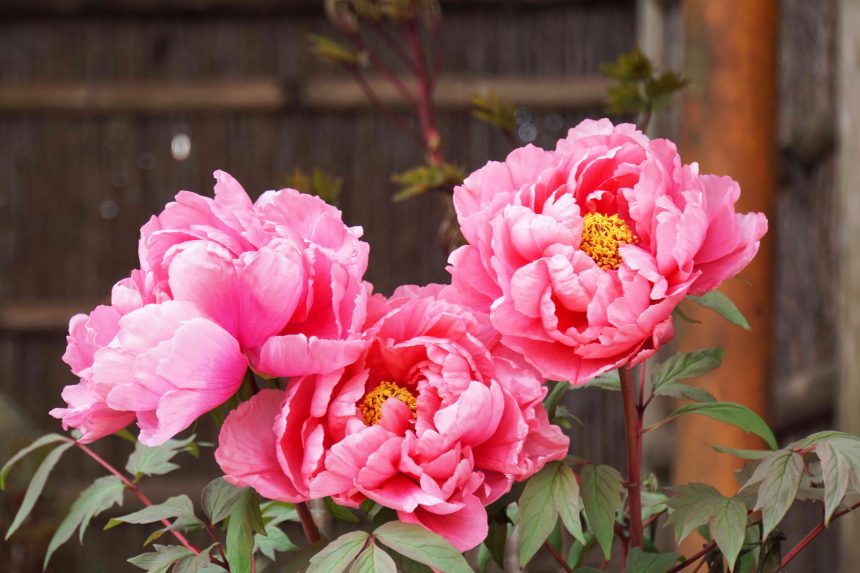Perennials are an essential piece of a garden, providing color, texture, and joy all throughout the growing season. There’s work to do on these plants in the winter, too, as trimming back perennials once they’re asleep for the season can help prevent many issues, like insects and disease—plus, the garden looks much tidier when free of any debris from spent plants. Here, we’ve brought together expert-backed recommendations on some of the perennials you should always cut back in the winter.
- Kathy Jentz, host of the GardenDC podcast, editor of Washington Gardener, and author of “Groundcover Revolution”
- Jan Johnsen, landscape designer and author of “Gardentopia: Design Basics for Creating Beautiful Outdoor Spaces”
Lantana
Anukoon Supawong / GETTY IMAGES
Lantana camara is irresistible to pollinators like hummingbirds and butterflies, and the shape, colors, and fragrance of the blossoms make it a favorite for gardeners, especially for container growth. And while it can be a problematic garden plant because of its invasive nature—if you have it planted directly in the ground, it is a good candidate for winter pruning.
“It’s best to cut back lantana in late winter or in the very early spring, as they’re normally dormant at that point,” says Kathy Jentz, editor of Washington Gardener and host of the GardenDC podcast. “Cut back the whole plant to about 6 to 10 inches from the ground.”
- Zones: 7 to 11
- Mature size: About 5 feet tall x 5 feet wide; smaller when kept pruned
- Care requirements: Full sun, well-drained soil
Wisteria
Perennial vines gradually expand their territory year after year. Wisteria in particular provides lovely lavender, white, pink, or blue composite flowers that droop beautifully off the vine’s main branches. Keep in mind, though, that the vine is ambitious and should definitely be kept off of buildings.
Proper pruning helps keep it where you want it and also encourages blooming. “Asian wisteria vines can be cut back in winter when the plant is dormant, and most of the leaves have fallen off, so you can get better access and a good view of what you’re cutting,” says Jentz. “You can cut back anything dead or damaged all the way back to the trunk.”
She recommends cutting back any vertical leaders reaching beyond your preferred height—these can be trimmed by about one-third. “Finally, any side branches can be cut back to two to three buds,” she says. “The buds are where the new growth will emerge in spring.” Note that some varieties, like American wisteria, should be pruned back in the spring, immediately after flowering.
- Zones: Generally 4 to 9, possibly zone 3 with some varieties of wisteria
- Mature size: The vine can spread over 30 feet in various directions
- Care requirements: Full or partial sun, moist, slightly acidic soil
Daylily
OlgaVolodina / GETTY IMAGES
Daylilies liven up the landscape with their bold, brilliant blossoms and charming colors; their thick, hardy foliage provides a beautiful accent in the garden—even when the plant isn’t in bloom. But winter—when the plant is finished for the growing season—is a fine time to do some Hemerocallis maintenance.
“Daylilies should also be cut back after the first frost,” says landscape designer Jan Johnsen. However, don’t cut them back too early. “Let the green foliage remain as long as you can. The green leaves make energy for the plant to thrive.”
Johnsen suggests waiting for the foliage to die back naturally: “When most of the leaves have become brown and limp, it’s time to cut back. You should use pruning shears to make a clean cut and prune back to the base of the daylily plant.”
- Zones: 3 to 9
- Mature size: 24 to 48 inches tall x 24 to 36 inches wide
- Care requirements: Full to partial sun, well-drained soil
Bee Balm
Photos by R A Kearton / GETTY IMAGES
If you haven’t already cleaned up your bee balm prior to winter, now’s the time. The tall, thin stalks that proudly support their vivid blossoms in the summer have by then faded to a crumbly brown. The plant will begin growing again in the spring, of course, but it will do so from the ground up with fresh growth—there’s no reason to keep the old stalks in place for winter.
- Zones: 3 to 9
- Mature size: 36 inches tall x 8 inches wide
- Care requirements: Full sun, plenty of water, well-drained soil
Catmint
AlpamayoPhoto / Getty Images
Catmint stays busy all summer as a pollinator’s paradise, but when winter arrives, it needs a bit of help. “Another popular perennial damaged by the cold days of winter is catmint,” says Johnsen. “The withered foliage should be cut back to 2 to 4 inches high after a first frost, or later in winter.”
Take care of your catmint, and you’ll be blessed with prolific growth, great scent, and attractive blossoms in the next growing season.
- Zones: 3 to 8
- Mature size: About 24 inches tall by about 24 inches wide
- Care requirements: Partial sun
Hosta
Irina Kosheleva / Getty Images
Hostas can be a valuable part of your landscaping, providing rich, beautiful foliage to help add structure and balance to your blooms. But this impressive foliage means you have some maintenance to do after the growing season is over.
“One of the most important perennials to cut back, in my opinion, are hostas,” says Johnsen. “Remove the old and tattered leaves a few inches above the ground after the first frost. This is important because decaying hosta leaves can shelter slugs— which may damage emerging leaves in the spring.”
Johnsen notes that rodents, such as voles, may also try to build a winter home in old hosta leaves. “This can be deadly [to the plant], as rodents may subsequently eat hosta roots,” says Johnsen.
- Zones: 3 to 9
- Mature size: About 12 to 24 inches tall x 12 to 24 inches wide, though some varieties may be larger
- Care requirements: Typically full to partial shade, moist soil
Coreopsis
Coreopsis is also sometimes called tickseed; regardless of nomenclature, it’s hardy, easy to grow, and provides a fun splash of tall, vertical color in a daisy-like package. This perennial benefits from keeping its old foliage intact over the winter to protect the crown from the cold—so plan on cutting back your coreopsis very late in the season, just as spring is ready to burst on the scene.
- Zones: 4 to 9, can be an annual farther north
- Mature size: 2 to 4 feet tall, sometimes taller
- Care requirements: Full sun, well-drained soil, even somewhat sandy
Bearded iris
Marina Denisenko / GETTY IMAGES
If you enjoy plants that put out large, lavish blossoms, you’ll find it easy to fall in love with irises. Bearded iris, in particular, come in a variety of stunning colors, with drooping flower petals accented by ruffled edges. Dormant-season maintenance can be key to help discourage disease and pest problems and keep your irises healthy.
“Cut back the iris blades to 6 inches in late fall or winter,” says Johnsen. “This prevents iris borers and fungal diseases from overwintering in the leaves.”
- Zones: 3 to 9
- Mature size: About 24 inches tall x about 12 inches wide
- Care requirements: Full sun, well-drained soil
Peony
jfbenning / Getty Images
A peony’s massive blooms and brilliant colors make it a must-have for any flower gardener. They also benefit from careful cleanup after the growing season. This can be done in the fall, but if you’ve fallen a bit behind schedule, they can definitely be cut back in the winter as well—just don’t wait too long!
“In my honest opinion, peonies are the most important perennial to cut back,” says Jentz. “By late summer and early fall, the leaves are looking tattered and worn. Often, they have powdery mildew on them, so you’re not doing the plant any service by leaving them on.” She adds that it’s best to cut affected parts of the plant and discard them, but don’t compost them—if they do have a disease, you don’t want it to spread.
- Zones: 3 to 9
- Size: Approximately 3 feet tall x 3 feet wide
- Care requirements: Full sun; moderate water; rich well-drained soil
Daisy
Ben185 / GETTY IMAGES
You might think of daisies as just friendly wildflowers, but you can grow them in the garden, too, and they’re absolutely lovely. When your daisies are wilted after frost, you can cut away a lot of the spent foliage but don’t overdo it. Leave several inches of the stems above the ground.
- Zones: Varies, 3 to 9
- Mature size: About 16 inches tall x 12 inches wide
- Care requirements: Full sun, well-drained soil
Columbine
Aquilegia can feature either hanging blossoms or upright flowers, and in both cases, the gardener has a huge selection of colors to choose from. Columbine blooms have a unique bell shape that’s absolutely beautiful, and these hardy perennials bring lovely colors year after year. Help them out through the winter by cutting them back nearly to the ground—and you might want to add a touch of mulch for cold protection, too.
- Zones: 3 to 9
- Mature size: About 24 inches tall x 12 inches wide
- Care requirements: Full sun or partial shade depending on type; well-drained soil
Yarrow
Liudmyla Liudmyla / GETTY IMAGES
Yarrow is easy to grow, fairly tolerant of dry weather, and requires minimal effort on the part of the gardener. But like so many other flowering perennials, Achillea millefolium can benefit from a bit of late-fall and early-winter cleanup—this will help make room for next year’s growth.
- Zones: 3 to 9
- Mature size: 24 to 36 inches tall x 24 inches wide
- Care requirements: Full sun, well-drained soil that is never too moist








